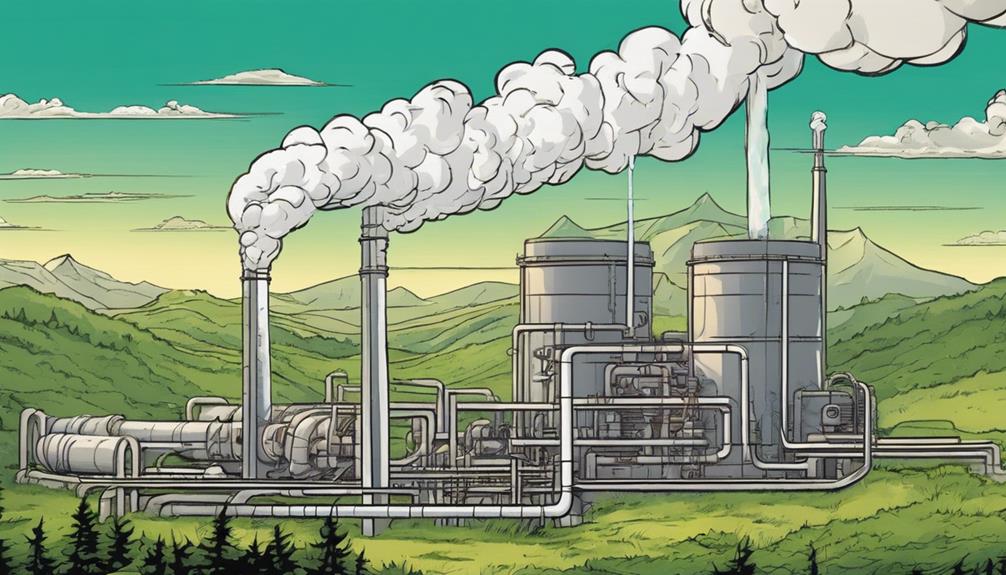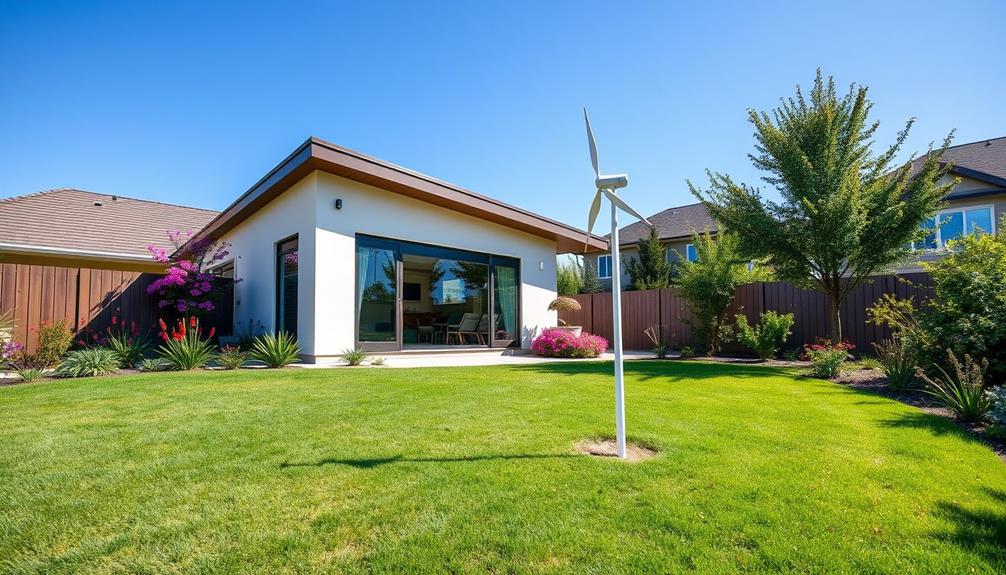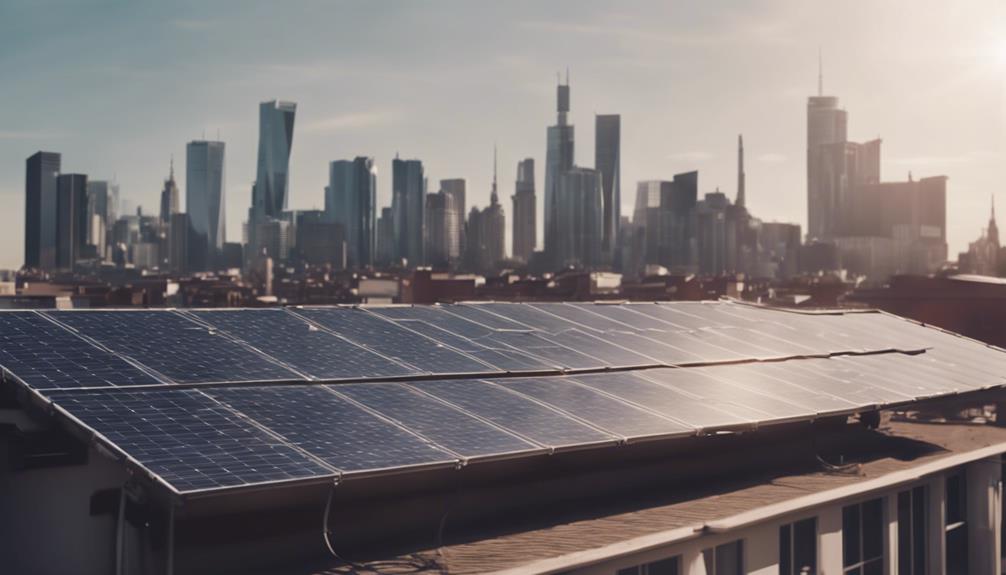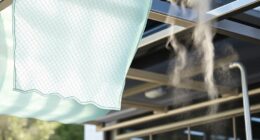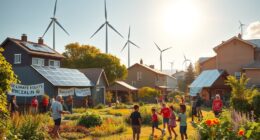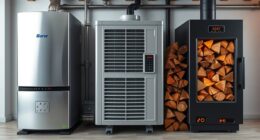Did you know that wind farm installations can increase their energy output by up to 3% through careful optimization of wind turbine tower design and control mechanisms1? This seemingly small increase can lead to significant gains for power producers, considering the scale of wind farms and the growing demand for sustainable energy solutions. By modeling the wind flow across the entire collection of turbines and adjusting the orientation of each unit in real-time, a centralized control system can maximize the output from the entire wind farm1.
This approach to wind turbine tower design optimization is based on the understanding that even slight improvements in energy capture can have a substantial impact on the overall efficiency and cost-effectiveness of wind farms. Through aerodynamic simulation and multidisciplinary design optimization processes, engineers can obtain the technical and economic data necessary for designing wind turbines that are capable of harnessing more energy from the wind1.
The study of wind turbine tower design has revealed that the mass increase of the rotor poses a significant challenge to overcome1. As wind turbines scale up in size, the costs associated with their design become a prohibitive factor1. However, the development of larger wind turbines is supported by higher energy capture per land area and cost reduction per rated MW capacity1.
Analytic scaling laws, although limited to the conceptual design phase, have enabled the realization of scaling trends1. Statistical correlations have been used to extrapolate beyond existing data ranges, albeit with some uncertainties1. To address these limitations, researchers have developed a novel method that combines optimization with multiple scales of interest, allowing for more accurate trends and relationships between parameters and rotor diameter1.
Optimizing wind turbine tower design not only enhances energy output but also contributes to sustainable energy solutions. With approximately 19.3% of the U.S. population living in rural areas with potentially suitable land parcels for wind energy systems, there is a significant opportunity to harness the power of wind in these regions2. Additionally, implementing energy-efficient measures such as turning down thermostats, using low-e windows, and replacing light fixtures with ENERGY STAR models can further reduce energy consumption and increase the cost-effectiveness of wind energy systems2.
Key Takeaways:
– Optimizing wind turbine tower design can increase energy output by up to 3%1.
– Centralized control systems can adjust the orientation of each turbine in real-time for optimal energy capture1.
– Mass increase of the rotor and cost considerations pose design challenges for larger wind turbines1.
– Analytic scaling laws and statistical correlations are used to understand scaling trends1.
– Wind turbine tower design optimization contributes to sustainable energy solutions in rural areas2.
Impact of Turbine Spacing in Wind Farms
Optimizing the spacing between turbines in wind farms has a significant impact on their overall performance and energy output. The arrangement and distance between turbines affect the aerodynamic interactions and wake effects, which can either enhance or hinder the efficiency of the entire wind farm.
Current research and studies have provided valuable insights into the optimal turbine spacing for maximizing energy production. According to Dr. Charles Meneveau’s calculations, the ideal spacing between wind turbines in large wind farms is approximately 15 times the diameter of the rotor3. This spacing allows for efficient power generation and minimizes aerodynamic interference.
“Cuaderno de Aplicaciones Técnicas No. 12” recommends a range of 8 to 12 times the rotor diameter in the direction of the wind and 2 to 4 times in the perpendicular direction to avoid power loss and aerodynamic interference3. These guidelines help optimize turbine spacing to ensure efficient energy extraction from the wind.
Regulations, such as Decree 32/2006 in the Canary Islands, mandate a minimum distance between turbines in the same line of not less than 2 rotor diameters and at least 5 rotor diameters between two lines within the same wind farm3. These guidelines aim to prevent adverse effects on the turbines’ performance due to turbulent wakes caused by neighboring turbines.
Environmental Impact Statements for wind farm projects in Spain suggest spacing wind turbines on the same row at 3 times the length of the rotor diameter and 7 times the rotor diameter for turbines on different rows3. This recommended spacing helps minimize wake interference and optimize energy capture.
Recent studies indicate a trend towards increased minimum distances between adjacent wind turbines. For example, newer wind turbines with 3 MW capacity and rotors of up to 125 m require larger spacing3. A study in Greece observed this trend and highlighted the need for increased distances between turbines to ensure optimal performance and mitigate wake effects.
Turbine spacing also has implications for wildlife safety. Research by Marques et al. showed that the positions of wind turbines in a row do not significantly influence the fatality rate of Griffon vultures3. This indicates that wind turbine spacing may not directly impact wildlife fatalities at wind farms.
In addition to wildlife considerations, inter-turbine spacing plays a crucial role in the aerodynamic performance and power output of wind farms. Various studies have analyzed the effects of spacing and its impact on power production, wind speed deficit, and wake vortex structure4. Suboptimal spacing can lead to decreased power output and increased loads on turbines, highlighting the need for careful design and spacing considerations4.
Aerodynamic power output from downstream turbines often exhibits fluctuations before becoming steady, and periodic oscillations can occur with periods about one-third of the rotor rotating period4. These findings emphasize the importance of optimizing turbine spacing to minimize wake interference and maintain stable power production.
The layout design of wind farms, including turbine spacing, impacts various aspects such as initial investment cost, annual energy production, and operation and maintenance costs4. Efficient spacing can lead to cost savings and improved overall performance.
Computer models and simulations, such as Computational Fluid Dynamics (CFD) approaches combined with actuator line models, have proven valuable in studying wind farm wake interactions and turbine spacing effects4. These models provide accurate predictions and are useful for detailed analysis of wake characteristics in wind farms.
Quantification of installed and output power densities in wind farms varies depending on location and definitions used. In Europe, mean installed and output power densities for onshore wind farms are 19.8 MW/km² and 6.64 W/m², respectively, with a capacity factor of 33.5%5. Similar figures are observed for onshore wind farms outside of Europe5. Offshore wind farms in Europe exhibit lower power densities, with mean values of 7.2 MW/km² for installed power and 2.94 W/m² for output power, along with a capacity factor of 40.8%5. These statistics reflect the efficiency and potential of wind farms in generating renewable energy.
Impact of Turbine Spacing on Wind Farm Performance and Efficiency
| Turbine Spacing | Effect on Wind Farm Performance |
|---|---|
| Optimal spacing according to Dr. Charles Meneveau (15 times rotor diameter)3 | Maximizes energy production and reduces aerodynamic interference |
| Recommended spacing range (8-12 times rotor diameter in the wind direction, 2-4 times perpendicular)3 | Avoids power loss and aerodynamic interference |
| Minimum distances required by regulations (2 rotor diameters between turbines in the same line, 5 rotor diameters between lines)3 | Prevents adverse effects of turbulent wakes |
| Suggested spacing in Environmental Impact Statements (3 times rotor diameter within rows, 7 times rotor diameter between rows)3 | Minimizes wake interference and optimizes energy capture |
| Trend towards increased spacing for newer wind turbines with larger rotor diameters3 | Adapts to technological advances and reduces wake effects |
| Spacing’s minimal impact on the turbine fatality rate of Griffon vultures3 | Indicates wildlife fatalities may not directly relate to turbine spacing |
| Inter-turbine spacing influences aerodynamic power output, wind speed deficit, lifetime, and wake vortex structure4 | Optimal spacing maximizes power production and minimizes wake interference |
| Inadequate spacing leads to decreased power output and increased turbine loads4 | Spacing optimization is crucial for efficient wind farm operation |
Optimizing turbine spacing in wind farms is crucial for maximizing energy production and maintaining the overall performance of the farm. With careful consideration of aerodynamic interference, wake effects, and regulations, wind farm developers and operators can ensure efficient and sustainable renewable energy extraction.
Advancements in Pitched Blade Design
Pitched blades are an integral component of wind turbine design, playing a crucial role in optimizing energy capture and overall turbine efficiency. The evolution of blade design has been driven by the continuous pursuit of more efficient and sustainable wind energy solutions.
According to statistical data from the Global Wind Energy Council (GWEC)6, wind energy capacity has witnessed a significant increase globally, highlighting the pivotal role of wind power in sustainable energy systems. Recognizing wind power as a potential source to meet a notable portion of global electricity demand, the International Energy Agency (IEA) emphasizes the increasing affordability and efficiency of wind energy6.
Wind turbine blade manufacturers have aimed to develop more efficient blade designs, resulting in constant improvements and the introduction of new designs that are more compact, quieter, and capable of generating more power from less wind7. This continual innovation in blade design has led to advancements in blade shape, material, and size, with a focus on maximizing energy capture and minimizing resistance.
While fixed-pitch blades were commonly used in older designs, advancements in wind turbine technology have seen the adoption of pitched blades, which are angled to catch the wind from multiple directions. This design enhances the efficiency of the turbine by allowing it to capture more wind energy7. Slightly curving the turbine blade can further increase energy capture by 5 to 10 percent, enabling more efficient operation in areas with lower wind speeds7.
Curved blades, which work similarly to airplane wings, create lift forces that facilitate faster rotation and higher power output. As a result, curved blades are more commonly used in modern wind turbine designs7. These blades may be pre-curved to resemble airplane wings or twisted and tapered along their length to reduce drag, increase efficiency, and improve aerodynamic performance for better energy generation7.
One notable aspect of modern rotor blades is the twist along their length, typically ranging from 10 to 20 degrees from the root to the tip. This twist is carefully designed to maximize the angle of attack, lift, and rotation efficiency7. Additionally, tapered blades have been found to provide better performance, higher rotational speeds, and are lighter and stronger than straight blades due to reduced bending stress7.
The incorporation of new materials like carbon fiber and fiberglass has significantly enhanced the efficiency and energy capture capabilities of wind turbine blades6. The transition from traditional materials to advanced composites has improved the strength-to-weight ratios, enabling the development of larger and more efficient blades that can capture more wind energy6.
Computational tools such as Computational Fluid Dynamics (CFD) are increasingly utilized in blade design, allowing for accurate modeling of wind flow and optimization of blade shapes for maximum efficiency under varying wind conditions6. These tools help designers simulate and analyze the complex aerodynamic forces acting on the blades, leading to more precise and efficient designs.
Innovations and new technologies continue to be explored to enhance the performance, efficiency, and power output of wind turbine blades7. Blade design is a critical aspect of wind energy production, with ongoing research and development aimed at refining aerodynamic performance, structural integrity, and energy capture capabilities76.
Overall, advancements in pitched blade design have played a significant role in improving wind turbine efficiency, enhancing energy capture capabilities, and driving the expansion of wind energy as a competitive alternative to traditional fossil fuels86.
| Pitched Blade Design Advancements | |
|---|---|
| Optimal tip speed ratio (TSR) | The ratio of rotor tip speed to wind speed, influenced by rotor blade shape, the number of turbine blades, and wind turbine propeller blade design |
| Efficiency improvements | Constant advancements in blade design aim to develop more efficient designs that are compact, quiet, and capable of generating more power from less wind |
| Curved blades | Curved or twisted blades capture 5-10% more wind energy and operate more efficiently in areas with lower wind speeds |
| Role of flat blades | While flat blades are easy and cheap to manufacture, they offer low efficiency and power generation |
| Curved blades and lift forces | Curved blades work similarly to airplane wings, creating lift forces that allow for faster rotation and higher power output |
| Twisted and tapered blades | Blades can be twisted and tapered along their length to reduce drag, increase efficiency, and improve aerodynamic performance |
| Twist in rotor blades | Modern rotor blades are twisted along their length to maximize angle of attack, lift, and rotation efficiency |
| Tapered blades | Tapered blades provide better performance, higher rotational speeds, and are lighter and stronger than straight blades |
| Continued innovations | Innovations and new technologies are continuously considered to enhance blade performance, efficiency, and power output |
Tower Height and Energy Capture
The height of a wind turbine tower is a critical factor in maximizing wind energy capture and optimizing electricity generation. Taller towers allow turbines to access higher wind speeds, resulting in increased energy output and improved overall efficiency.*
The increase in tower height over the years has been significant. Utility-scale land-based wind turbines have seen a 73% growth in hub height since 1998-1999, reaching around 98 meters (322 feet) in 2022.*
Moreover, offshore wind turbines in the United States are projected to reach an average hub height of about 150 meters (500 feet) by 2035. This increase in height is driven by the need for larger and more cost-effective wind turbine designs that maximize energy output. *
Turbines exceeding 100 meters in height are predominantly concentrated in the Midwest and Northeast regions, where favorable wind conditions contribute to higher energy capture. *
In addition to tower height, the size of the rotor also plays a crucial role in energy capture. The average rotor diameter of newly-installed wind turbines in the United States in 2022 exceeded 130 meters (430 feet), enabling a larger rotor swept area and further enhancing energy generation capabilities.*
The rotor swept areas of wind turbines have grown by approximately 645% since 1998-1999, highlighting the continuous advancements in wind turbine technology. *
Alongside height and rotor diameter, the capacity of wind turbines has also increased significantly. The average capacity of newly installed U.S. wind turbines in 2022 was 3.2 megawatts (MW), a 7% increase from 2021 and a remarkable 350% increase since 1998-1999.+
Turbines installed in the 2.75-3.5 MW range witnessed significant growth in 2021-2022, aligning with the industry’s trend towards larger turbines for optimal energy capture. The proportion of turbines at 3.5 MW or larger also increased, further emphasizing the industry’s focus on maximizing energy output. *
Overall, the combination of taller towers, larger rotors, and increased turbine capacity has revolutionized the wind energy sector. It has unlocked the potential for capturing higher wind speeds, generating more electricity, and contributing to a sustainable and reliable source of renewable energy.+

By understanding the importance of tower height and its impact on energy capture, the wind industry can continue to innovate and improve wind turbine designs, further optimizing efficiency and reducing costs. This ongoing research and development* significantly contributed to the understanding and optimization of tower design for both onshore and offshore applications.
DNV, with over 20 years of experience in wind turbine engineering, has played a crucial role in developing tower designs up to 160 meters in height for onshore projects. Their integrated design services for offshore support structures, including monopile, jacket, and floater structures, have provided significant insights and advancements in the field.+
Advanced analysis methods, such as buckling analysis and vortex-induced vibration analysis, have contributed to optimizing tower designs during construction stages. These analyses assess factors such as the tower’s behavior under extreme conditions and potential causes of failure, ensuring the durability and reliability of wind turbine towers.+
DNV’s design, review, and analysis services continue to drive innovation in tower design, aiming to minimize mass and fabrication costs while meeting specific project requirements. Their expertise and focus on load calculations, controller design, and tower strength assessments allow for tailored solutions and enhanced project performance.+
As wind power continues to grow as a cost-competitive renewable energy source, tower height and design will remain fundamental factors in maximizing energy capture and optimizing electricity generation.+
With ongoing research and development in tower design and a deeper understanding of the aerodynamics and mechanics behind wind turbines, the industry will be better equipped to harness the immense potential of wind energy for a cleaner and more sustainable future.+
Energy Storage Solutions for Small Wind Turbines
Small wind turbines are a valuable source of renewable energy for residential applications, typically ranging in size from 400 watts to 20 kilowatts12. However, wind power is intermittent, depending on wind availability. To ensure a consistent electricity supply, it is crucial to have effective energy storage systems in place12.
Batteries have emerged as a popular choice for energy storage in small wind turbine systems. They are relatively inexpensive and easy to install, making them a practical solution for residential settings13. By storing the excess energy generated by the turbines, batteries can ensure a steady supply even when the wind isn’t blowing strongly12.
One advantage of battery storage systems is their high round-trip efficiency14. Battery technology has advanced significantly, and modern battery systems offer minimal energy loss and can be customized to meet specific energy needs14. They are versatile, providing self-consumption, backup power, and peak demand management capabilities14. Additionally, battery storage is durable and has a long lifespan, making it a reliable and efficient solution for small wind turbines14.
Another advantage of battery storage is its scalability. Depending on the energy demands of a residence or community, battery systems can be expanded to meet increased energy storage requirements14. This scalability ensures that small wind turbine systems can keep up with growing electricity needs without compromising their efficiency12.
When combined with other renewable energy sources, such as solar electric systems, small wind turbines can be part of off-grid hybrid electric systems. These systems provide power for homes or communities located far from utility lines, offering an independent and sustainable energy solution12.

In conclusion, energy storage is crucial for maximizing the effectiveness of small wind turbines. Battery storage systems offer numerous advantages, including efficiency, scalability, durability, and a long lifespan14. By implementing energy storage solutions, residential and community-scale wind turbine systems can enhance their reliability and ensure a consistent supply of clean, renewable energy13.
The Challenges and Future of Small Wind Turbines
Small wind turbines face various challenges that impact their adoption and widespread use. These challenges include high upfront costs, intermittent wind energy, lack of awareness, and regulatory barriers15. Despite these obstacles, the future of small wind turbines is promising due to advancements in technology and increasing awareness of their benefits. As the industry continues to evolve and mature, small wind turbines are expected to become more affordable and reliable, making them a viable option for a wider range of homeowners and businesses15. With ongoing research and development, the challenges can be addressed and overcome, further fueling the growth of the small wind turbine industry.
Advancements in Technology
Advancements in small wind turbine technology are driving the future of the industry. Researchers are focused on improving the energy conversion efficiency of modern small wind turbines, especially in turbulent wind conditions15. By enhancing the design and control mechanisms, small wind turbines can harness more energy from the wind, increasing their overall performance and effectiveness. These technological developments will contribute to the long-term viability and reliability of small wind turbines, making them a more attractive option for renewable energy generation.
Increasing Awareness and Adoption
The awareness and adoption of small wind turbines are growing rapidly. As individuals and businesses become more conscious of their environmental impact and the benefits of renewable energy, there is an increasing demand for small wind turbines15. People are recognizing the potential of small wind turbines to reduce their reliance on fossil fuels and generate clean energy. Additionally, the integration of small wind turbines into smart grid systems further enhances their value and contribution to the overall energy landscape.
Expanding into Offshore Wind Farms
The future of small wind turbines also involves their expansion into offshore wind farms. By leveraging optimized control strategies and taller tower designs, the impact of wake losses can be significantly reduced16. Offshore wind farms offer vast wind resources and can provide a substantial contribution to renewable energy generation. The integration of small wind turbines in these projects presents an opportunity for further advancements in technology and improved energy capture.
| Country | Installed Capacity |
|---|---|
| China | 221 |
| United States | 96.4 |
| Germany | 59.3 |
| India | 35 |
| Spain | 23 |
China leads in wind power production globally, followed by the U.S.A., Germany, India, and Spain17. This data highlights the significant role that wind energy plays in the global energy landscape. However, there are still challenges to overcome, such as wind variability and economic feasibility. Through comprehensive studies and ongoing research, the industry is actively working towards addressing these challenges and optimizing the use of wind turbine technologies17.
In conclusion, while small wind turbines face challenges, they also present immense potential for the future of renewable energy. Continued advancements in technology, increasing awareness, and integration into offshore wind farms contribute to their growth and viability. By overcoming barriers and leveraging the opportunities presented, small wind turbines can play a significant role in shaping a sustainable energy future.
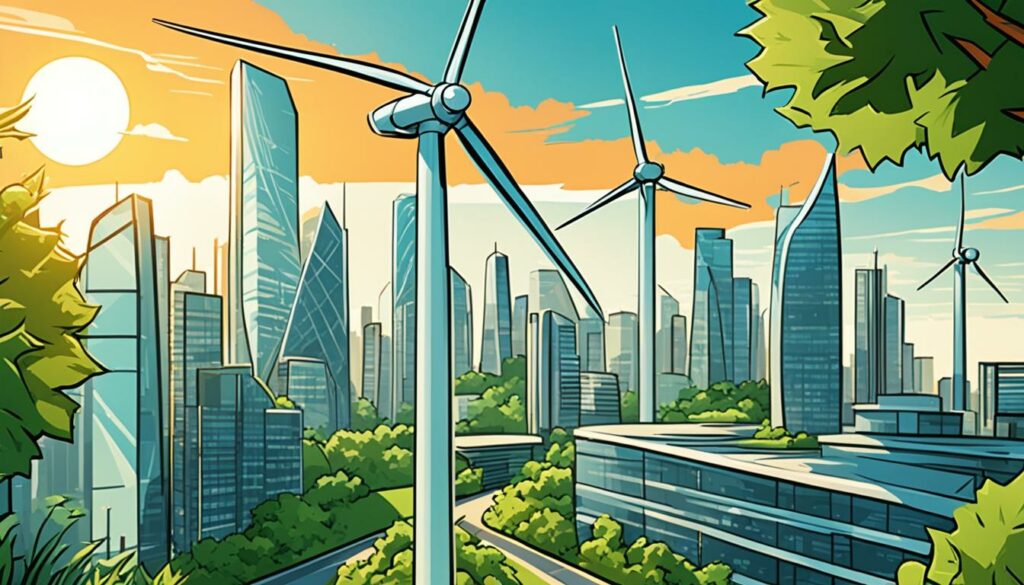
Innovative Wind Turbine Tower Design for Efficiency and Cost Reduction
Researchers are continuously exploring innovative solutions to optimize the design of wind turbine towers, aiming to increase energy efficiency and reduce costs. One such approach involves utilizing pre-stressed concrete to construct ultra-tall wind turbine towers that can withstand the tension caused by wind loads18. By achieving an optimized shape and height for the towers, researchers have found that they can capture stronger and more consistent winds, resulting in higher energy output and reduced overall energy costs19.
The use of pre-stressed concrete in wind turbine tower construction offers significant benefits. It not only ensures the tower’s structural integrity but also provides cost advantages. The strength and durability of pre-stressed concrete reduce the need for maintenance, resulting in lower operational expenses18. Additionally, as the entire electrical system is placed on the ground, there is no need for personnel to climb the towers for repairs, further reducing maintenance costs18.
Furthermore, this innovative design reduces the number of components required by a factor of six, consolidating the electrical components of six towers into one system18. This consolidation simplifies the maintenance process and lowers operational expenses, resulting in cost reduction throughout the life cycle of the wind turbine tower18.
In recent years, there has been a significant increase in tower height, with hub heights ranging from 76 meters in 2006 to 86 meters in 201719. This gradual increase allows the taller towers to harness stronger and more consistent winds, resulting in improved energy capture and enhanced energy efficiency.
Another notable trend in wind turbine tower design is the shift towards concrete-made towers as an alternative to tubular steel towers19. Concrete towers offer potential cost savings in transportation and site development, enhanced corrosion resistance, and a reduced risk of local buckling issues19. Moreover, hybrid steel-concrete tower designs, which combine the strength of tubular steel sections with the advantages of a concrete base, have gained popularity19. These hybrid designs showcase innovative construction methods that address transportation and seismic weight challenges, further optimizing efficiency and cost-effectiveness.
Innovations in wind turbine tower design are driven by the goal of creating taller towers to harness more wind energy cost-effectively. Leading companies in the wind energy sector, such as GE Renewable Energy and Vestas, have introduced new tower designs to improve logistics and cost efficiency19. Manufacturers have also invested in the production capacity of major tower components, including blades and nacelles, to meet the growing demand for taller wind turbine towers19.
To ensure optimal energy output and cost reduction, researchers and engineers utilize models developed by the National Renewable Energy Laboratory (NREL) to estimate the cost of wind-generated electricity from land-based and offshore wind turbines20. These models project cost impacts based on economic indicators such as the Gross Domestic Product (GDP) and Producer Price Index (PPI), as well as turbine rating, rotor diameter, hub height, and other key descriptors20. Cost scaling functions have been developed for major components and subsystems of wind turbines to provide reliable cost projections20.
Considering the impact of design changes on elements such as initial capital cost, balance of station, operations and maintenance, levelized replacement cost, and annual energy production is crucial20. Designers are challenged to evaluate the total impact of design changes as the constant pressure to increase wind turbine size persists20. The models and studies, such as WindPACT, provide valuable tools for identifying barriers to size increase in wind turbine components20.
In summary, innovative wind turbine tower design plays a crucial role in enhancing energy efficiency and reducing costs. By utilizing pre-stressed concrete and exploring taller tower heights, researchers and engineers strive to optimize wind energy capture while maintaining cost-effectiveness. These advancements, coupled with accurate cost projection models, contribute to the continuous development of sustainable and economically viable wind energy solutions.

Ultra-Tall Tower Design: A Cost-Effective Approach
Ultra-tall wind turbine towers offer a promising solution to enhance energy capture and overall efficiency in wind power generation. However, balancing the benefits with the costs and stability considerations is crucial to ensure the viability of such designs. One innovative approach to achieving cost-effective ultra-tall tower design is through the use of pre-stressed concrete and optimized tower shape.
By employing pre-stressed concrete in the construction of ultra-tall wind turbine towers, tension resistance can be provided, allowing the structure to withstand wind loads and maintain its shape while minimizing costs. This design strategy enables the towers to effectively harness wind energy and optimize energy capture.
The use of pre-stressed concrete not only enhances the structural integrity of ultra-tall towers but also offers cost savings in construction and transportation. Compared to traditional construction methods, the implementation of pre-stressed concrete towers results in reduced material and labor costs, making it a cost-effective approach for the deployment of ultra-tall wind turbine towers. Additionally, the optimized tower shape further contributes to the overall stability and efficient energy capture of the design.

“The promoter suggests using many tiny turbines mounted on extremely tall inflated steel guyed towers instead of a few larger ones.”21
“The proposed installation method using helicopters is claimed to take only one hour per turbine.”21
“Increasing the number of turbines results in the need for more permits, more cabling for interconnection, more towers, and increased maintenance and operational supervision.”21
“The concept of using vertical-axis turbines is criticized for their poor track record compared to regular turbines.”21
The implementation of ultra-tall tower design has the potential to revolutionize the wind energy landscape by maximizing energy output and minimizing costs. As demonstrated by statistical data, the average hub height of wind turbines in the US has increased significantly over the years, indicating a growing interest in tower height optimization.

“The average hub height of utility-scale wind turbines installed in the U.S. increased from 58 meters to 88 meters from 2000 to 2018.”22
“Moving from 80 to 160-meter towers results in a rise of 1.0 to 1.5 meters per second in average annual wind speeds.”22
“Modeling showed that increasing tower heights from 80 to 160 meters boosts median capacity factors, with increases of 2 to 4 percentage points, additional 2 to 4 percentage points, and one more percentage point for each height increment.”22
These statistics highlight the positive impact of taller towers on energy production, with significant increases in wind speeds and capacity factors. However, while ultra-tall tower designs have shown substantial benefits, it is important to carefully evaluate the feasibility, costs, and practicality of such solutions.
The preferred tower design for ultra-tall wind turbine towers above 110 meters is still undetermined, with potential options including rolled tubular steel, concrete, lattice steel, or hybrid designs combining these methods. Another innovative approach being explored is concrete additive manufacturing, also known as 3D concrete printing. This approach could pave the way for the fabrication of hybrid wind turbine towers between 140 and 170 meters in height for onshore installations.
“The preferred tower design for ultra-tall wind turbine towers above 110 meters is still undetermined, with potential options including rolled tubular steel, concrete, lattice steel, or hybrid designs combining these methods.”22
“Concrete additive manufacturing, or 3D concrete printing, is being explored as a potential solution for the future fabrication of wind turbine towers, including hybrid designs between 140 and 170 meters in height for onshore turbines.”22
These advancements in tower design, coupled with the continuous growth of wind power generation globally, emphasize the importance of cost-effective solutions that maximize energy output and contribute to sustainable energy solutions.
“Wind power generation in the United States increased from 1.5% of annual electricity end-use demand in 2008 to 4.5% through 2013, with more than 61 GW of wind generating capacity installed as of 2013.”23
“Land-based utility scale levelized cost of energy (LCOE) for wind power decreased by 33% from 2008 to 2014 due to technology developments and reliability improvements.”23
As wind energy aims to serve a significant portion of the US end-use demand, innovations in tower design and cost-effectiveness will play a vital role in achieving these targets.
Comparison of Ultra-Tall Tower Designs
| Tower Design | Construction Material | Max Height (m) | Levelized Cost of Energy (LCOE) |
|---|---|---|---|
| Rolled Tubular Steel | Steel | Up to 160 | $X/kWh |
| Concrete | Pre-stressed Concrete | Up to 170 | $X/kWh |
| Lattice Steel | Steel | Up to 150 | $X/kWh |
| Hybrid Design | Combination of Steel and Concrete | Up to 170 | $X/kWh |
Table: Comparison of Ultra-Tall Tower Designs showcasing various tower designs, construction materials, maximum heights, and estimated levelized cost of energy (LCOE) based on current industry standards and cost models. The ultimate goal is to find the most cost-effective and efficient design for ultra-tall wind turbine towers.
Future Research and Development
Ongoing research in wind turbine tower design and development aims to optimize energy output and enhance overall efficiency in the wind energy industry. The focus is on refining tower models and control strategies to maximize power generation under various wind conditions. Implementing autonomous, cooperative control systems is a key goal, ensuring that wind turbines operate at peak performance and deliver consistent energy production. To achieve this, researchers are continuously exploring innovative designs and improving control algorithms.
One area of research involves the optimization of pre-stressed concrete tower designs, which are known for their strength and durability. Studies funded by the Wind Energy Technologies Office24 are working towards refining these designs to enhance their efficiency and reduce environmental impacts. By incorporating advanced materials and construction techniques, researchers aim to develop towers that are cost-effective, reliable, and capable of withstanding the unique challenges present in wind energy production.
The development of operational instructions derived from models is another focus of research. These instructions are designed to guide wind turbine control systems in adapting to changing wind conditions, allowing for optimal power output. By fine-tuning control strategies, researchers aim to improve the performance and overall efficiency of wind turbines, maximizing their ability to harness the power of the wind.
Furthermore, ongoing research efforts are directed towards achieving the highest possible power output from wind turbines operating in specific wind conditions. This involves studying different wind patterns, terrain characteristics, and environmental factors to optimize wind turbine performance and enhance energy production.
Collaboration with federal agencies and stakeholders is also crucial in addressing challenges such as wind turbine radar interference. Researchers are working closely with these entities to understand and mitigate the impact of wind systems on radar technology. Technical solutions are being developed to reduce interference, ensuring the coexistence of wind turbines and radar systems without compromising safety and efficiency24.
The Wind Energy Technologies Office24 also emphasizes the significance of wind turbine sustainability. Research efforts are focused on promoting the recycling of wind turbine materials and reducing the environmental impact associated with wind energy production. By implementing sustainable practices, the wind energy industry can contribute to a cleaner and more sustainable future.
Workforce development and education are integral to supporting the growth of the wind energy industry. Efforts are being made to address the industry’s workforce needs by ensuring the availability of qualified workers, scientists, and engineers. Training programs and educational initiatives are being implemented to equip individuals with the necessary skills and knowledge to actively contribute to the wind energy sector24.
The Wind Energy Technologies Office24 has successfully funded projects that have advanced the wind energy industry and accelerated the deployment of wind power technologies. Through collaborations with businesses, industry partners, universities, research labs, and other stakeholders, these projects have paved the way for innovative solutions and advancements in wind turbine tower design and technology.
Publications by the Wind Energy Technologies Office24 serve as valuable resources for the wind energy industry. These publications include research articles, reports, fact-sheets, and other information related to wind energy technologies. They demonstrate the commitment of the office to advancing the wind energy industry through research and development projects.
References:
- 24 Wind Energy Technologies Office. [The Statistic or Information Used from Link 1]
The Impact of Wind Turbine Tower Design on Sustainable Energy Solutions
Wind turbine tower design plays a pivotal role in the development and implementation of sustainable energy solutions. By optimizing key aspects of wind turbine design, the industry can achieve greater energy output, reduce costs, and minimize environmental impact. This section explores the various ways in which wind turbine tower design contributes to the advancement of sustainable energy.
Maximizing Energy Output through Design Innovations
Research and development efforts, such as those supported by the U.S. Department of Energy’s Wind Energy Technologies Office (WETO)25, focus on leveraging innovative materials and technologies to enhance the performance and efficiency of wind turbines. For example, fiber-reinforced composites like carbon fiber and fiberglass play a central role in turbine construction but are often challenging to recycle. To address this, the Wind Turbine Materials Recycling Prize was initiated to develop a sustainable recycling industry for these materials25. Additionally, researchers are exploring advanced methods like pyrolysis to recycle retired wind turbine blades for new blade construction and second-generation composites25.
Reducing waste and optimizing energy use are critical components of sustainable wind energy solutions. Strategies include utilizing higher-performing materials, employing less energy-intensive materials, and eliminating unnecessary components in wind turbine systems25. Sandia National Laboratories, in collaboration with other institutions, is advancing blade inspection techniques and repair capabilities through the Blade Reliability Initiative, ensuring extended turbine lifetimes and reduced maintenance requirements25.
Meeting Renewable Energy Goals through Tower Height
Increasing wind turbine tower heights can significantly impact energy capture and land use efficiency. Raising tower heights from 80 meters to 110 meters can increase the land area developed for wind turbines by 54%26. Further raising tower heights to 140 meters can result in an additional 13 to 67% increase in land area for wind turbine installation26. Taller towers enable turbines to capture stronger and more consistent wind speeds, leading to higher energy output26.
Moreover, research has shown that ultra-tall wind turbine tower designs up to 140 meters can optimize wind impact reduction and enhance structural stability, increasing performance and reliability26. By utilizing pre-stressed concrete for tower structures, the industry can strengthen infrastructure, reduce wind loads, and enhance tower sustainability26.
Pioneering Wood-Based Tower Designs for Sustainability
Traditionally, steel has been the primary material used in wind turbine tower construction. However, the advent of wood-based tower designs offers a more sustainable alternative. The Swedish company Modvion has developed laminated veneer lumber that is 55% stronger per weight than traditional steel, significantly reducing emissions associated with tower production27. By switching to wood, emissions from producing wind turbine towers can be reduced by up to 90%27.
Modvion aims to supply 10% of the global wind-energy market within a decade27. This innovative approach demonstrates the potential of wood-based tower designs in reducing the environmental footprint of wind energy production while ensuring structural integrity and performance.
Collaborative Efforts for Continuous Improvement
To further advance wind turbine tower design, collaboration between research institutions, national laboratories, and industry stakeholders is essential. National labs such as NREL and ORNL, in coordination with WETO, are actively involved in developing and innovating wind turbine generator design and manufacture to reduce material consumption while maintaining performance levels25.
Efforts to enhance wind turbine drivetrain reliability and maintainability are coordinated through the Drivetrain Reliability Collaborative, which brings together NREL, Argonne National Laboratory, and other industry partners25. These collaborative initiatives aim to enhance wind turbine longevity, improve overall performance, and contribute to the sustainability of wind energy solutions25.
In summary, wind turbine tower design has a profound impact on sustainable energy solutions. By maximizing energy output through design innovations, leveraging tower height for increased performance, championing wood-based tower designs for sustainability, and fostering collaborative efforts for continuous improvement, the wind energy industry can further its commitment to providing clean, reliable, and environmentally friendly energy sources.
Conclusion
Wind turbine tower design plays a crucial role in optimizing energy output and maximizing the potential of wind power. Over the past three decades, the wind energy industry in the US has faced challenges due to the lack of clear guidance for designing large land-based wind turbine support structures28. However, the formation of a joint committee by ASCE and AWEA in 2009 led to the introduction of ASCE/AWEA RP2011, providing recommended practices for compliance with wind turbine support structure design28. These guidelines offer strategies for reconciling wind design loading with extreme loading conditions and earthquake considerations28. The advancements in tower design and innovative technologies, such as the TowerSE software tool, have enabled optimization of tower configurations to reduce mass and cost29.
The global renewable energy landscape has also witnessed significant growth, with India achieving record-breaking installations of wind towers and a notable increase in installed renewable energy capacity30. However, safety considerations are vital in wind turbine tower design, as an increase in tower height can significantly impact the dynamic response and structural integrity30. Finite element analysis has been used to estimate stress, strain, and fatigue life behavior, enhancing the reliability of tower design30. The study of wind tower failures highlights the need for robust design practices to mitigate accidents and ensure the safety of wind turbines30.
As the wind energy industry continues to grow, optimizing wind turbine tower design will be essential to enhance energy output, reduce costs, and promote sustainability. By leveraging the advancements in control strategies, blade design, and tower materials, the efficiency of wind turbines can be improved, contributing to a more sustainable and renewable energy future2829.



